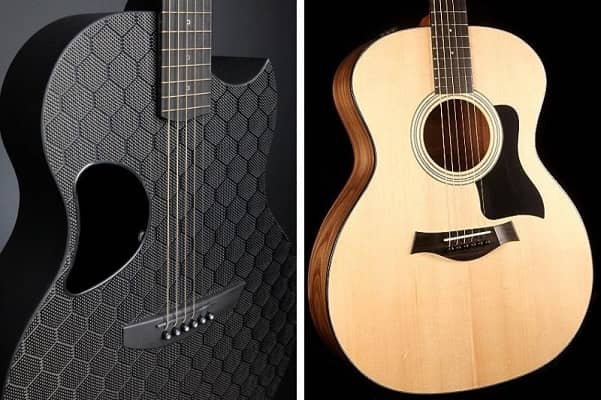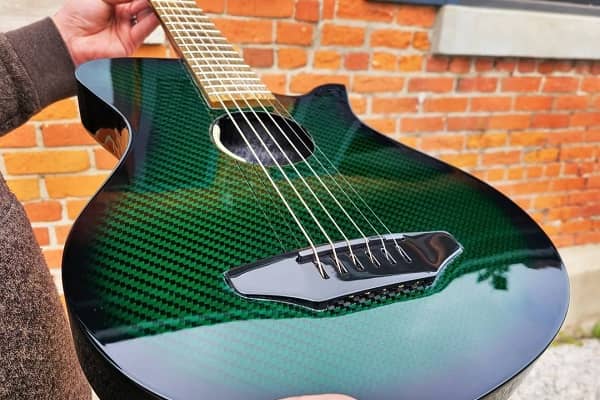I’ve noticed something about myself and my fellow musicians over the years as a guitar player. We love tradition. We often want the same instruments and equipment that our favorite musicians use.
Once we find the right instrument, we’re not always quick to change. We might be excited about the latest sound equipment and amp technology, but we like our guitars the way they’ve always been.
At least, I’ve always felt this way until I recently picked up a carbon fiber guitar. It immediately felt different from any traditional wooden guitar I’ve played, but the sound was amazing. This set me on a journey to learn more about carbon fiber guitars and how they stack up to their more traditional counterparts.
Overview Of Carbon Fiber & Wooden Guitars
Making guitars out of alternative materials isn’t really new. Charles Kaman, a musician and aeronautical engineer, had the idea as far back as the mid-1960s. He eventually founded Ovation Instruments, and in 1976, the first guitar with a fiber-glass composite soundboard was created.
There are a number of benefits to using carbon fiber instead of wood. Carbon fiber guitars have high chemical resistance to temperature and humidity changes when compared to traditional wooden guitars. They won’t warp and change due to rain, humidity and extreme weather fluctuations.
I’m no stranger to electric guitars built of various materials. Carbon-fiber necks and fiberglass bodies have been around for a long time. How much this affects the tone of an electric instrument is a hotly debated topic in the guitar world.
When it comes to acoustic guitars, there’s no debate at all, the building materials drastically affect the tone. We’re going to take a close look at how carbon fiber acoustic guitars compare with wood acoustic guitars, and what are the pros and cons of each material.
Carbon Fiber Vs Wood Guitar: Comparison Of Various Aspects
Carbon fiber and wood possess distinct properties and characteristics that influence the sound, resonance, durability, weight, appearance, and other aspects of musical instruments.
In this section, we will compare these materials in various aspects, as well as discuss their respective advantages and disadvantages.

Tone Differences
It’s hard to quantify one material being better than the other when comparing a wood guitar’s tone to a carbon fiber guitar.
Some carbon fiber models that I’ve tried sound very close to wood, especially at the higher price points. There’s also a lot of variation between different types of wood, hence the pursuit of exotic tone woods.
Many of the carbon fiber instruments I’ve played had a bright tone that a lot of musicians may prefer. I personally don’t think there’s a clear winner here. Wood doesn’t necessarily mean better tone, but it does often mean more familiar and desired tones.
Sound Projection And Resonance
You can’t discuss carbon fiber vs wood guitars without talking about resonance and sound projection. Resonance is how the body of your guitar vibrates. The resonance of the soundboard is the primary cause of your instrument’s sound.
I’ve found that carbon fiber can resonate just as well as most woods if the proper shape and thickness is used. They can also be just as thin and resonate as wood acoustic guitars but with more strength and stability.
When it comes to projection, many carbon fiber guitars sound louder than my favorite wood guitars. This makes carbon fiber a good choice for musicians who play small gigs without the benefit of a mic or amplifier.
Unlock the Sound Showdown: Watch this captivating YouTube video comparing carbon fiber and wooden guitars!
Playability And Comfort
Playability and comfort are largely subjective. If properly designed, a carbon fiber instrument can be just as comfortable as a wooden instrument. Some models use a rounded back for better sound projection.
These, I personally found a bit cumbersome to play, but everyone’s tastes are different in this category. I recommend trying these for yourself to see how it feels to you.
Wood necks and fingerboards feel a lot more comfortable to play on for me personally, but this may just be what I’m used to. I suspect a lot of long-time musicians will feel the same. This, more than anything, is likely what’s holding carbon fiber models back from market dominance.
Weight And Portability
Weight and portability are two more categories that favor the carbon fiber guitar. They’re not only lighter, they’re also stronger. This makes them ideal for travel, or just for taking to the beach or campsite.
It’s much easier to take the carbon fiber guitar with you than it is to lug your prized wooden model along. The fact that carbon fiber models are almost immune from the elements also adds to their portability, in a different sense of the term.
Visual Appearance And Finishes
I personally think that the classic wooden acoustic wins here. There are countless woods to choose from, each giving the guitar a different appearance.
The wood used in the soundboard can be mixed and matched with different woods for the sides, back and bracing of the guitar. The neck can also be made of a different wood and then have a rich ebony or rosewood added for the fingerboard.
It may be my own personal bias, but I believe nothing beats the looks and finishes of a wooden acoustic guitar.
Construction And Design
When it comes to overall design, the classic acoustic guitar is a work of genius. The modern steel-string acoustic was invented in the mid 1830s by Christian Frederick Martin.
Classic acoustic guitars go back to the 16th and 17th centuries. That’s a long time period for luthiers to perfect the instrument. Tradition and experience are on the side of the wood guitar.
Carbon fiber is among the most durable fibers known to man. These guitars can be made without internal bracing. The soundboard of a guitar needs to be thin in order to resonate properly.
Wood isn’t as sturdy as carbon fiber, so wooden braces need to be put into place to support the structure. Not only is carbon fiber lighter than wood, but the lack of bracing takes the overall weight of the instrument down even further.
Durability And Longevity

The carbon fiber guitar wins this category hands down. Carbon fiber is stronger and more durable than wood. It won’t warp and deteriorate from the elements or time.
A good wooden guitar can outlast you if it’s taken care of. A carbon fiber guitar will still outlast it and doesn’t require as much upkeep and caution. They’re even harder to break from accidental bumps and drops.
Customization Options
Further elaborating on our last category, the acoustic guitar has more possibilities for customization, at least where the looks are concerned. That’s not to say that carbon fiber guitars are without possibilities, but they will largely be relegated to the color of the body and soundboard.
The possibilities for rich wood grains and patterns are endless, and one can easily get something unique with a traditional guitar.
On models with a carbon fiber neck and fingerboard, I have yet to see expensive, attractive inlays like one might find on an expensive wooden guitar. I’m sure something like that exists, but I haven’t discovered it yet in my local music shops.
Cost Comparison
Traditional wood wins here. Carbon fiber guitars are generally more expensive to make, even when compared to the use of exotic tone woods.
While shopping for guitars, I’ve found it much easier to find playable, good-sounding wood acoustics than I have for carbon fiber models. The more affordable carbon fiber guitars tend to be travel models, or they lack the great sound qualities I’ve found even in inexpensive wooden guitars.
You can get something comparable in sound with carbon fiber, but it will definitely cost you.
Environmental Impact
This is yet another win for carbon fiber guitars.
Deforestation is a real problem in the world. In recent years, a number of laws have caused guitar manufacturers to stop using some of their favorite traditional woods.
One example is the use of rosewood for fingerboards on both acoustic and electric guitars. Fender famously switched to using Pau Ferro wood for a number of their instrument lines. Even with the law changes, rosewood continues to be popular for use in acoustic guitar body construction.
Many guitar manufacturers have had to change their policies, making sure they source wood from responsible suppliers that replant what they harvest.
Over the decades, rare and sometimes endangered wood species have been used in high-priced guitars. If you care about the environment, the idea of carbon fiber guitars starts to seem really appealing.
Final Thoughts
As I tested a number of guitars and did research on this topic, carbon fiber guitars slowly won me over. I’m not ready to do away with my wooden acoustics quite yet, but carbon fiber models definitely have a place in my collection now.
They are great instruments for travel, playing outdoors or camping trips. I really appreciate how durable and maintenance-free these guitars are.
The sound quality and projection of carbon fiber guitars really surprised me. There will always be a place for traditional instruments. Nothing will ever replace them, but it’s good to have options.
Advancements and change aren’t something to be feared. If you haven’t tried a carbon fiber instrument yet, give it a shot. You might be as surprised as I was!
Photos: Journey Instruments (Don Alder with Carbon Guitar) | Mcpherson Guitars (Carbon Fiber Sable) & Taylor Guitars (114e GA) | Synergy Guitars (Customized Slim Body Acoustic)
About the Author
Gustavo is a music teacher and classical guitar player from Brazil, currently residing in Dublin, Ireland. He holds a graduate degree in Classical Guitar Performance from the Federal University of Pelotas. In 2020, Gustavo successfully completed a Master's degree in Sound Engineering from the Academy of Sound in Ireland.



